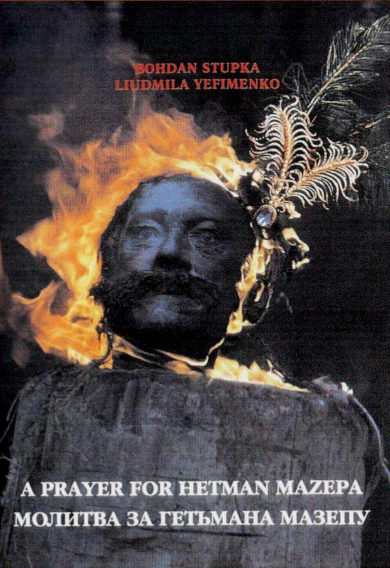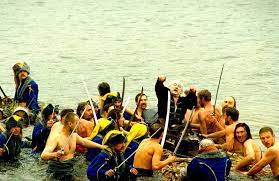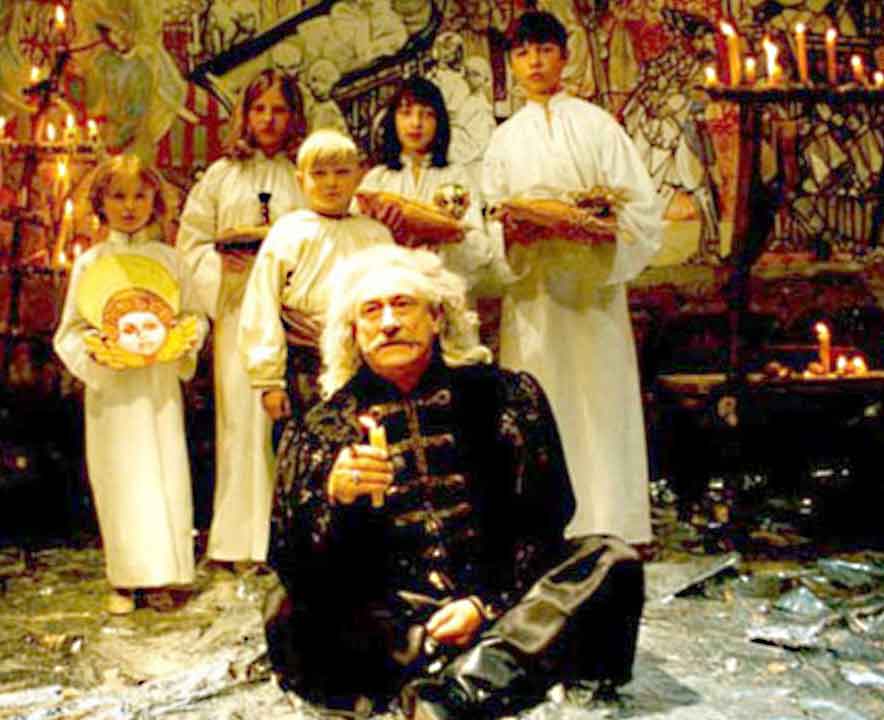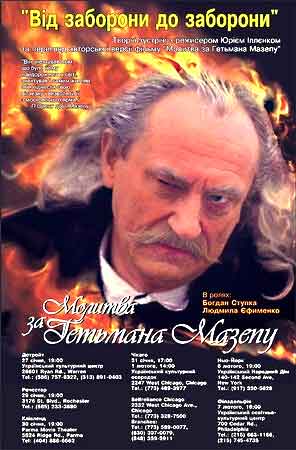 With the conflict between Russia and the Ukraine exploding, I say it’s an opportune time to revisit the 2002 Ukrainian feature A PRAYER FOR HETMAN MAZEPA (MOLITVA ZA GETMANA MAZEPU), which offers a most unorthodox treatment of this centuries-long skirmish. The last feature to be directed by Yuri Ilyenko (1936–2010), one of the founders of the Ukrainian poetic cinema movement of the 1960s, it was in its day the costliest film ever made in the Ukraine—and a massive flop.
With the conflict between Russia and the Ukraine exploding, I say it’s an opportune time to revisit the 2002 Ukrainian feature A PRAYER FOR HETMAN MAZEPA (MOLITVA ZA GETMANA MAZEPU), which offers a most unorthodox treatment of this centuries-long skirmish. The last feature to be directed by Yuri Ilyenko (1936–2010), one of the founders of the Ukrainian poetic cinema movement of the 1960s, it was in its day the costliest film ever made in the Ukraine—and a massive flop.
…in its day the costliest film ever made in the Ukraine—and a massive flop.
The subject was Ivan Mazepa (1639-1709), who served as Hetman (Ukrainian head of state) of Left-bank Ukraine from 1687 to 1708. Since Ukraine’s official break from Russia in 1991, Mazepa has been viewed as a cultural hero in his native land (even as his name remains blackened in Russia, where this film was and is effectively banned). This film’s backers appear to have been hoping for a stately period epic (along the lines, perhaps, of Ilyenko’s 1984 film THE LEGEND OF PRINCESS OLGA/LEGENDA O KNYAGINE OLGE), but what Ilyenko delivered was a hallucinatory fever dream packed with scatology and excess that hews closer to the work of cinematic provocateurs like Ken Russell and Andrzej Zulawski than it does BRAVEHEART.
Since Ukraine’s official break from Russia in 1991, Mazepa has been viewed as a cultural hero in his native land (even as his name remains blackened in Russia, where this film was and is effectively banned).
The opening scene, of a map of Europe in the form of a naked woman with the Ukraine located in the crotch area, effectively sets the tone of a film whose major centerpiece is the 1709 Battle of Poltava. History tells us that during the skirmish Mazepa, frustrated by the news that Russia’s emperor Peter the Great was planning on replacing him as Hetman, allied himself with the invading Swedish and Polish fighters. Russia’s armies, in addition to roundly defeating the invaders, retaliated by sacking Hetman’s hometown Baturyn and sending a procession of crucified corpses floating down the Dnieper River.
All those events are covered here, albeit in highly surreal fashion. The Battle of Poltava occurs in the background of a scene in which two men calmly argue their respective positions at an outdoor feast surrounded by blazing guns and falling bodies, while the Baturyn massacre is portrayed by a literal flood of severed heads, body parts and blood poured down a hillside, and the floating procession via several platforms’ worth of corpses contorted into odd poses. Striking images, to be sure, but viewers without a working knowledge of Ukrainian history probably won’t know what to make of them.
The portrayal of Mazepa himself (played by Bogdan Stupka and, in flashbacks, by Ilyenko’s son Filipp) isn’t much more grounded. He’s first seen rising from the dead to confront Peter the Great (Vyacheslav Dovzhenko), who’s in the act of savagely defiling Mazepa’s coffin. Peter is portrayed (as are all the Russian characters) as a loutish drunk, led a mummified skeleton amid blatantly artificial scenery. Furthering the artifice is a play put on by a supporting character about Ukraine’s woes, which frequently intersects with the “reality.”
Peter the Great is portrayed (as are all the Russian characters) as a loutish drunk, led a mummified skeleton amid blatantly artificial scenery.
Ilyenko’s aims appear to have been similar to those of his late colleague Sergei Paradjanov (for whom Ilyenko photographed SHADOWS OF FORGOTTEN ANCESTORS/TINI ZABUTYKH PREDKIV in 1965, and adapted the treatment for SWAN LAKE: THE ZONE/LEBEDYNE OZERO. ZONA in 1990) in THE COLOR OF POMEGRANATES/SAYAT NOVA (1969), with highly arcane, culturally specific imagery substituting for traditional storytelling. Ilyenko, alas, didn’t have Paradjanov’s talent for poetic symbolism, resulting in a film that registers as a frenzied muddle (an effect not helped by the fact that the two hour version currently making the online rounds was pared down considerably from the initial 152 minute runtime, which explains the choppy and discordant editing).
Yet it’s a fascinating muddle. Ilyenko was one of the cinema’s most gifted visual magicians, and has created a pictorial cavalcade that takes the much-remarked-upon excesses of his earlier films THE EVE OF IVAN KUPALO/VECHIR NA IVANA KUPALA (1968) and A STORY OF THE FOREST: MAVKA/LISOVA PISNYA. MAVKA (1981) to new heights. Acting (as he usually did) as his own cinematographer, Ilyenko provides ultra-mobile handheld camerawork that’s downright spastic, with the madness enhanced by distorted lenses and multi-hued filters. Why Ilyenko felt the material needed such a frenzied treatment is unknown, but his passion for the subject matter, and its thematic underpinnings—represented by a climactic depiction of the undead Mazepa being seduced by an armor-plated semi-nude woman (played by Ilyenko’s wife and frequent co-star Lyudmila Efimenko) who for some reason impales herself on a sword, in what was evidently intended as a symbolic depiction of the relationship between Ukraine and Russia—is fully evident.
Vital Statistics
A PRAYER FOR HETMAN MAZEPA (MOLITVA ZA GETMANA MAZEPU)
Dovzhenko Film Studios/Vision XXI Media Group
Director/Screenwriter/Cinematographer: Yuri Ilyenko
Producer: Igor Didkovsky
Editing: Eleonora Summovskaya
Cast: Bogdan Stupka, Lyudmila Efimenko, Nikita Dzhigurda, Vyacheslav Dovzhenko, Viktor Demertash, Ekaterina Lisovenko, Filipp Ilyenko, Sergey Marchenko, Serhiy Alyoshechkin, Oleksandr Bezruchko, Viktor Kruchina, Marina Petrenko, Sergey Romanyuk, Les Serdyuk



